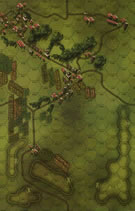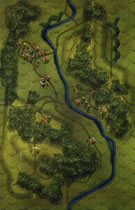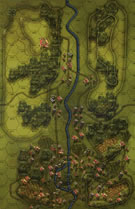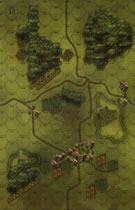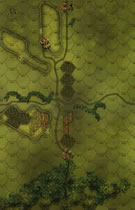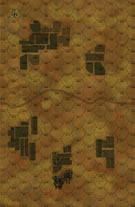|
Pépé le Moko Polish Exiles #8 |
||
|---|---|---|
| (Attacker) Germany | vs |
France
(Defender)
Morocco (Defender) Poland (Defender) |
| Formations Involved | ||
|---|---|---|
| Germany |  |
33rd Infantry Division |
| Poland |  |
10th Armored Cavalry Brigade |

|
| Overall Rating, 1 vote |
|---|
|
3
|
| Scenario Rank: --- of 964 |
| Parent Game | Polish Exiles |
|---|---|
| Historicity | Historical |
| Date | 1940-06-20 |
| Start Time | 00:08 |
| Turn Count | 36 |
| Visibility | Day |
| Counters | 104 |
| Net Morale | 0 |
| Net Initiative | 2 |
| Maps | 6: 28, 29, 30, 31, 33, 36 |
| Layout Dimensions | 86 x 84 cm 34 x 33 in |
| Play Bounty | 209 |
| AAR Bounty | 167 |
| Total Plays | 1 |
| Total AARs | 1 |
| Battle Types |
|---|
| Bridge Control |
| Exit the Battle Area |
| Inflict Enemy Casualties |
| Conditions |
|---|
| Off-board Artillery |
| Randomly-drawn Aircraft |
| Joint Forces Battle |
| Scenario Requirements & Playability | |
|---|---|
| Deluge | Counters |
| Fall of France 2 | Maps + Counters |
| Polish Exiles | Base Game |
| Swallows of Death | Counters |
| Introduction |
|---|
|
North of Valencay, France The Maczek group left much of the 10th Armored Cavalry Brigade's strength behind when it deployed to the front, including the tankless 2nd Tank Battalion commanded by Major Zygmunt Chabowski (who had commanded the Polish 2nd Tank Battalion in the September Campaign as well). As soon as Chabowski received his long-awaited armor - 21 R35 light tanks with long-barreled guns and 24 R40 light tanks - he headed east with his battalion in search of the rest of the Polish brigade. German advances had cut off that route, so he turned his battalion southward toward Sologne. On the 19th the Polish tankers crossed the river Cher and joined up with the 8th Cuirassiers, another wandering unit seeking Germans to fight. Their division command had set them to blocking the German advance, and with no other orders, Chabowski decided to help them. |
| Conclusion |
|---|
|
The bridge at Selles-sur-Cher (the large town on Board 30) had been conquered on the evening of 19 June by a surprise attack from German reconnaissance troops. Further east, at Chabris (the town south of the river on Board 29), the French had maintained a roadblock across the river, around the bridge. Behind the Cher, The French defense spread out in depth, blocking routes to the south with various groups including a few Polish tanks. On the morning of 20 June, the Germans were blocked at Chabris by a delaying group led by Aspirant André Jullien (a staff officer of the 19th Infantry Division). A roadblock had been improvised with around twenty men, mostly clerks and orderlies from Jullien's headquarters staff. This initial nucleus was reinforced by a W15 tank destroyer (nicknamed "Pépé le Moko"), engineers and a 75mm field gun from the 306th artillery regiment. A few French armored vehicles were also positioned behind the first line of defense. The Chabriotes protested; on the 17th, Marshal Philippe Pétain, head of the new government, had broadcast that, "I tell you, it is necessary to stop the fighting." Jullien told them to leave their homes immediately, because his men and the Polish tankers had no intention of giving up the fight. The French held off the Germans in Chabris throughout the morning, inflicting considerable losses on their opponents - Jullien would later claim that between 200 and 300 Germans were killed. At 0700, the 75mm cannon hit an armored vehicle head on; it burned on the spot, obstructing access to the bridge. Shortly afterward, several hits on a German convoy on the right bank of the river caused ammunition trucks to explode. At around 1000, as the convoy finished burning, the French and Poles granted the Germans an brief cease-fire to collect their wounded and dead. Fighting resumed half an hour later. The Germans reinforced their artillery, and two hits destroyed the W15 while the 75mm field gun ran out of ammunition. By 1430 the French had pulled back. The Germans moved through Chabris, murdering two civilians along the way, and soon ran into the 8th Cuirassiers holding the Nahon valley. The Germans pressed on to the small town of Valenҫay, but there the French defense held firm. Further west, the Germans advanced rapidly from Selles-sur-Cher, already occupied the day before. German elements reached Luҫay-le-Mâle, west of Valenҫay, behind the Gatine forest. The village was defended by a small rearguard of the Armée de Paris, including a few Polish tanks, reconnaissance troops and elements of a colonial unit. Two Polish tanks were lost in a confused battle. |
| Additional Notes |
|---|
|
The special rules select one French truck as having a machine gun armament; you may wish to use a Trunk MG counter from La Campagne de Tunisie. Counters from White Eagles may be used instead of those from The Deluge. |
| AFV Rules Pertaining to this Scenario's Order of Battle |
|---|
|
| 5 Errata Items | |
|---|---|

|
In 1940: Fall of France, the units show Direct Fire. All units are Indirect Fire. (rerathbun
on 2015 Jun 06)
|

|
Two 105mms (ID#s 1204, 1205) have "16-31" fire values in black (direct fire), when they should be in white (indirect fire). (Shad
on 2010 Dec 15)
|

|
The reduced direct fire value of the Heer HMG became 5-5 starting with Fall of France. (plloyd1010
on 2015 Jul 31)
|

|
The morale and combat modifiers of German Sergeant #1614 should be "0", not "8". (Shad
on 2010 Dec 15)
|

|
The movement allowance on the counters in Airborne is misprinted. It should be "3." (rerathbun
on 2012 Jan 30)
|
| Polish Exiles #8 - Pépé le Moko |
|---|
|
The French are trying to hold several key bridges across the Cher River, but their forces are spread out, low in numbers and quality but they do have a good size mobile reserve with a squadron of cavalry, a company of Dragoons and a company of R35 tanks. The Germans deployed in three groups, one for each cluster of bridges on maps 29 & 30, with the third group in the center consisting of the engineers, Fusiliers, cavalry and armored cars. The French right flank was the first to give way, they put up a good fight at first until the casualties started to mount and their local reserves were brushed aside, once the Germans had the four bridges captured their mobile forces headed south to exit the need eight steps. This fight could have gone either way, surprisingly it was the Moroccans who gave way first. |
| 0 Comments |

 PoEx007
PoEx007 



